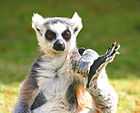Rare species
A rare species is a group of organisms that are very uncommon, scarce, or infrequently encountered. This designation may be applied to either a plant or animal taxon, and may be distinct from the term endangered or threatened species. Designation of a rare species may be made by an official body, such as a national government, state, or province. However, the term more commonly appears without reference to specific criteria. The IUCN does not normally make such designations, but may use the term in scientific discussion.[1]
Rarity rests on a specific species being represented by a small number of organisms worldwide, usually fewer than 10,000. However, a species having a very narrow endemic range or fragmented habitat also influences the concept.[2] Rare species are not uncommon, since nearly 75% of known species are rare.[3]
A species may be endangered or vulnerable, but not considered rare if—for example—it has a large, dispersed population, but its numbers are declining rapidly or predicted to do so. Rare species are generally considered threatened because a small population size is more likely to not recover from stochastic events (things that could happen).
| Common Name | Binomial/Trinomial Name | Conservation Status | Population | Global Range |
|---|---|---|---|---|
| Giant panda | Ailuropoda melanoleuca | Endangered | 1,000 to 3,000 | China |
| Pinta island tortoise | Chelonoidis nigra Abingdonii | Most likely Extinct | N/A | N/A |
| Wild Bactrian camel | Camelus ferus | Critically Endangered | 950 | Kazakhstan/Northwest China/Southern Mongolia |
| Cheetah | Acinonyx jubatus | Vulnerable | 7,000 to 10,000 | Africa/Southwestern Asia |
| California condor | Gymnogyps californianus | Critically Endangered | 130 approx. | West North America |
| Alagoas curassow | Mitu mitu | Extinct in the Wild | 130 (in captivity) | North East Brazil |
| Black softshell turtle | Nilssonia nigricans | Extinct in the Wild | 150 to 300 (in captivity) | Hazrat Sultan Bayazid Bastami shrine at Chittagong |
See also
- Abundance (ecology)
- Biodiversity Action Plan
- Chelonoidis nigra abingdonii
- Common species
- Critical depensation
- Endangered Species Recovery Plan
- Rare Species Conservation Centre
References
- ↑ Categories & Criteria (version 3.1) IUCN, 2001.
- ↑ R.MacNally and G.W.Brown, Reptiles and Habitat Fragmentation in the Box-ironbush Forests of Central Victoria, Australia: Predicting Compositional Change and Faunal Nested-ness, Oecologia 128:116-125 (2001)
- ↑ Dinerstein, Eric (2013) The Kingdom of Rarities Island Press. ISBN 9781610911955.
Further reading
- Gorbunov, Y.N., Dzybov, D.S., Kuzmin, Z.E. and Smirnov, I.A. 2008. Methodological recommendations for botanic gardens on the reintroduction of rare and threatened plants Botanic Gardens Conservation International (BGCI)
| ||||||||||||||||||||||||||||||||||||||||||||||||||||
